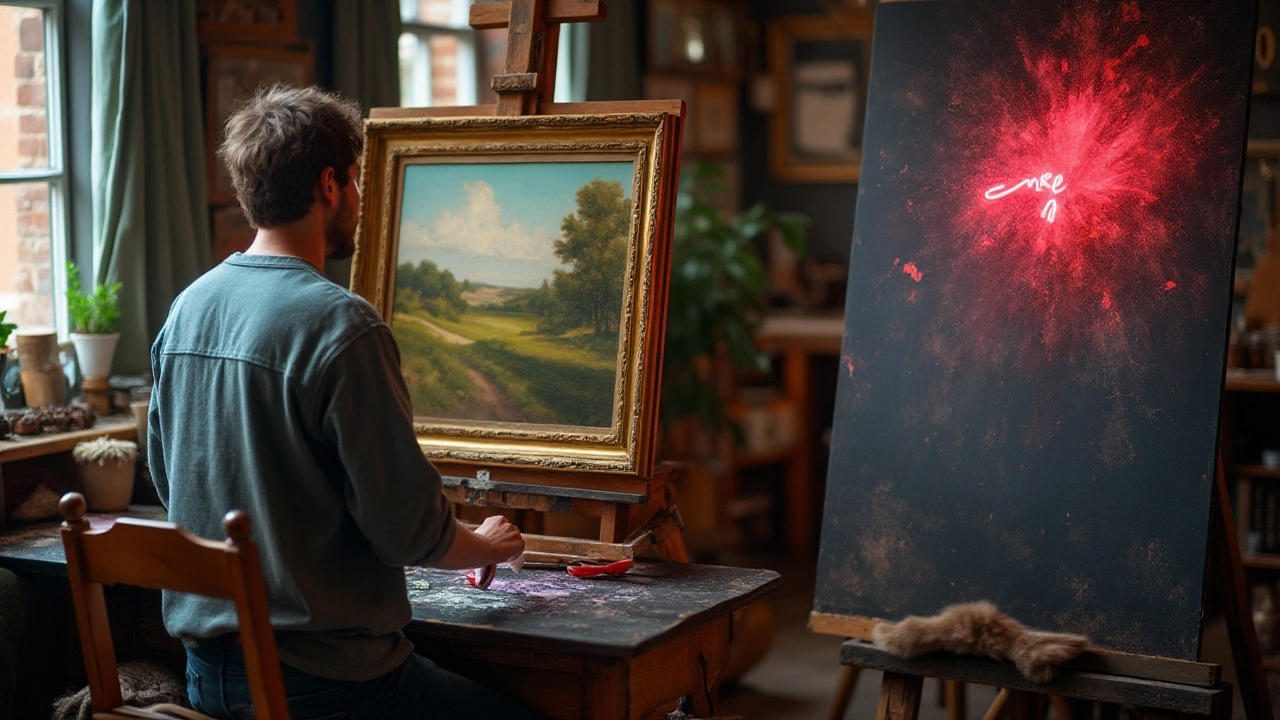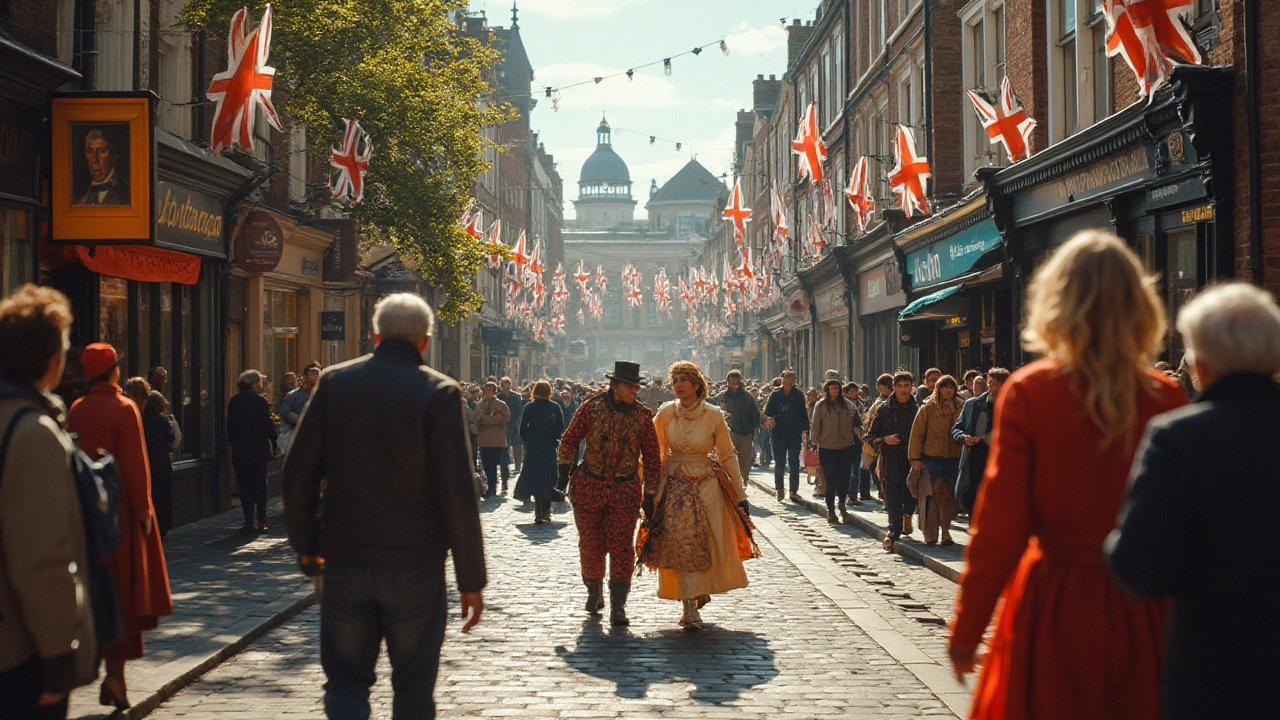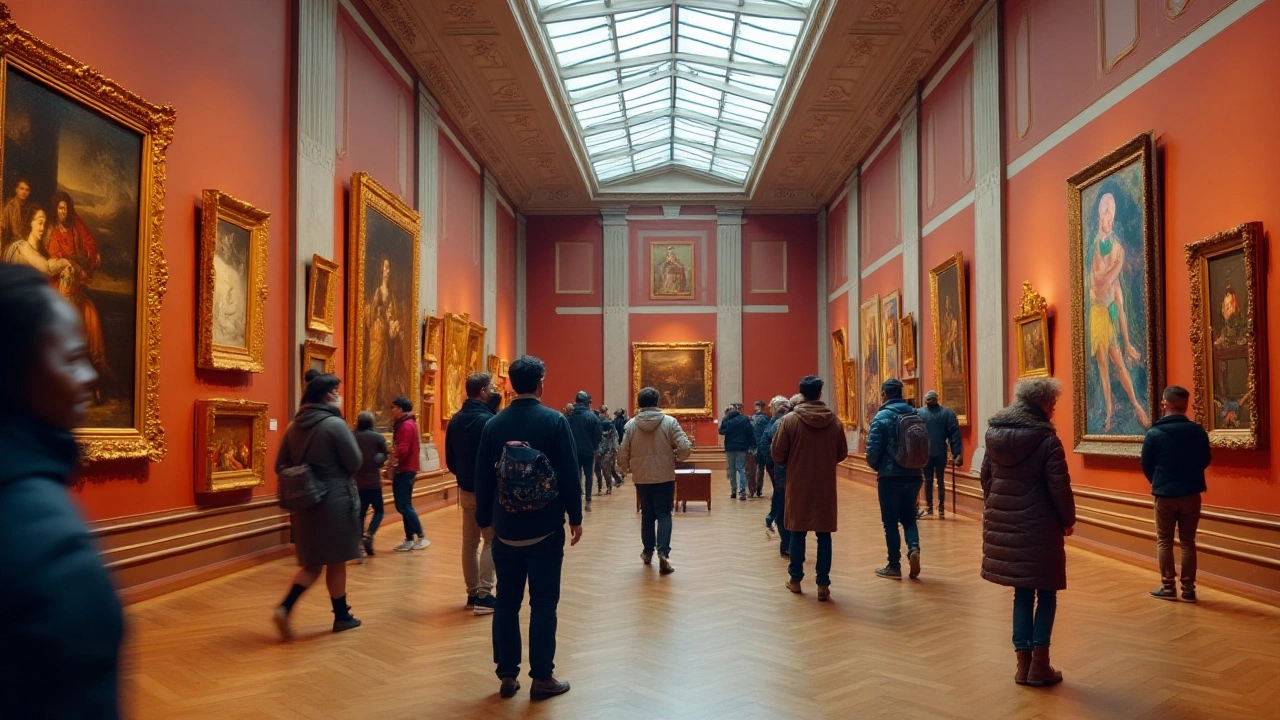Imagine walking through a gallery where the air whispers tales from bygone eras and the walls vibrate with the pulse of modern innovation. The world of art is a mesmerizing blend of the past and the present, and understanding the difference between classic and contemporary styles can deepen our appreciation.
Classic art is often steeped in tradition, reflecting historical moments and meticulous techniques. It's an echo of the past, carrying with it the weight and wisdom of times long gone. Meanwhile, contemporary art steps boldly into the future, pushing boundaries and exploring new ideas. This style thrives on change, capturing the ever-shifting landscape of human thought and culture.
With each brushstroke and chisel, artists weave stories from their respective worlds. Let us delve into the characteristics that define these two grand narratives of art, appreciate their unique contributions, and hopefully see the art that surrounds us with a more enlightened gaze.
- Defining Classic Art
- Exploring Contemporary Art
- Innovations and Influences
- Art in Cultural Contexts
- Tips for Art Appreciation
Defining Classic Art
Classic art often serves as a grand repository of history and culture. It's like stepping into a world where walls speak, and every piece whispers stories of a time long past. Recognized for its adherence to traditional techniques and philosophies, classic art typically spans from the ancient period through the Renaissance, encompassing the Baroque, Rococo, and parts of the early 19th century. Distinguished pieces often depict religious subjects, mythology, and scenes from history, portraying them with a sense of dignity and drama that resonates with historical grandeur.
The techniques of classic art are deeply rooted in painstaking accuracy and detail. Artists invested years honing their craft, focusing on perspectives, proportions, and anatomy, giving life-like qualities to their subjects. The use of chiaroscuro—a technique manipulating light and shadow—imbues the art with depth and emotion, a hallmark of this style. This dedication to realistic representation is best exemplified in works by luminaries like Leonardo da Vinci and Michelangelo, whose masterpieces continue to captivate audiences worldwide.
The themes in classic art are no less significant, predominantly revolving around nobility, divinity, and the complexities of human nature. Biblical stories, heroic figures from ancient myths, are brought to life on canvas and marble alike. Consider the awe-inspiring Sistine Chapel ceiling, where every inch narrates tales of creation, emotion, and divine drama. It's a testament to how classic art encapsulates not just an era, but an entire worldview.
Impact and Legacy
Beyond its visual splendor, classic art holds profound influence over contemporary works. The stringent focus on humanism, characterized by an intense study of human expression and emotion, paved the way for modern storytelling in art. Its legacy is vivid in today's culture, visible in everything from cinema to literature, where echoes of these classic inspirations continue to inspire new generations.
The allure of classic art is its timeless ability to transcend the temporal constraints of its creation. As Charlotte Brontë once noted, art is a reflection of reality, not just a mere copy.
"I am no bird; and no net ensnares me: I am a free human being with an independent will," expressed Brontë, emphasizing the spirit that classic art seeks to capture, reflecting an eternal essence of freedom and self-exploration.As we stand before these works, we're reminded of the shared human experience—our triumphs, beliefs, and the age-old quest for meaning.
The enduring appeal of classic art lies in its universal narratives and exquisite execution. Even as the world moves forward, the shadows and lights of these masterpieces continue to speak to the core of our being, urging us to pause, reflect, and appreciate the depth of the human condition. When visiting grand museums, from the Louvre to the Vatican, make sure you take a moment to admire these testaments to human creativity and resilience. These works are not just showcases; they are gateways into a time when art was both a reflection and an aspiration.
Exploring Contemporary Art
Contemporary art is a vibrant and ever-evolving expression of modern culture and society. It is unique in its refusal to be pinned down by a single medium or form. Whether through painting, sculpture, installation, or digital media, contemporary artists breathe life into the canvas with innovative techniques and diverse narratives. This art form is characterized by bold experiments and breaking traditional barriers. It often tackles complex themes like identity, politics, and technology, reflecting the intricacies of modern existence. Unlike classic art, which tends to adhere to certain established norms and techniques, contemporary art thrives in its rejection of convention, often prioritizing concept over form.
The origin of the term "contemporary" in art dates back to the post-World War II era when society began questioning the status quo, prompted by rapid technological advances and shifting cultural attitudes. The term itself is a moving target, representing work created since the 1960s until today. A significant element of contemporary art is its global perspective, as artists from diverse backgrounds contribute to an international conversation. These artists use their platforms to address issues important to them, creating pieces that challenge viewers to think critically about the world around them.
Engagement with contemporary art often requires a willingness to embrace ambiguity and uncertainty. It's this unpredictability that makes it so compelling, offering viewers a fresh lens through which to view their realities. For those interested in experiencing contemporary art, visiting galleries and museums is just one step. Availability of online exhibits and artist interviews provides unprecedented access to the minds behind this ever-changing style. Interacting with contemporary art means more than just viewing. It involves discussions, reflections, and sometimes even discomfort as familiar concepts are turned upside down.
"Art is not freedom from discipline, but disciplined freedom." – John F. Kennedy
Major exhibitions have become platforms for contemporary art to reach a broad audience, offering an insight into its dynamic landscape. Events like the Venice Biennale or Art Basel serve not just as showcases but as statements about current trends and societal issues influencing today's art world. Here, audiences can appreciate how new technologies like virtual reality and AI are shaping art production and consumption. Such innovations are not just decorative but are stirring the soul of contemporary artistic expressions, pushing what we know as art into new territories.
Critics and enthusiasts alike have noted the democratic nature of contemporary art. It welcomes interactivity, inviting participation through installations and performances. By breaking the traditional barrier between the artist and the observer, contemporary art challenges us to be active in interpretation. This engaging process enhances the experience, making contemporary art something people live through, rather than merely observe. Thus, those who approach art with open minds stand to gain the most, as contemporary art often holds mirrors up to our lives, revealing unexpected perspectives.

Innovations and Influences
The dance between classic art and contemporary style is not merely a matter of different techniques or ideas; it is an ongoing dialogue where new influences constantly shape the creative landscape. Classic art, with its emphasis on skill and tradition, has laid a solid foundation upon which the house of contemporary art stands. However, stepping beyond this foundation, contemporary style is known for daring to explore uncharted territories. Early in the 20th century, for instance, the world witnessed a seismic shift in artistic expressions. Movements such as Dadaism and Surrealism emerged, challenging perceptions and encouraging artists to delve into psychology and dreams.
One cannot talk about innovations without mentioning the avant-garde movements. These artistic currents sought to break away from established norms and conventions that defined classic art. The post-World War II era, known for abstract expressionism, gave artists like Jackson Pollock and Mark Rothko a canvas to convey raw emotion, using unpredictable and revolutionary painting techniques. This desire to explore and utilize new materials and mediums continues to fuel the evolution of art in our present age. Recently, technological advances have also become an integral part of contemporary art, with artists experimenting with digital platforms, virtual reality, and even artificial intelligence as tools to stretch the boundaries of creativity.
"Art is not a mirror to reflect reality, but a hammer to shape it." — Bertolt BrechtContemporary style does not simply react to changes but actively seeks to provoke new thinking. Today, contemporary artists draw inspiration from a plethora of influences, from global politics and social movements to environmental concerns. The world is their muse, and they aim to create art that not only speaks to the current generation but also transcends cultural boundaries. This inclusivity and adaptability make contemporary art a potent force in breaking down barriers, both physically in the art itself, and metaphorically in the dialogues it inspires.
Moreover, contemporary style finds its advocates across varied platforms. Social media has become an essential medium where art reaches diverse audiences, facilitating cultural exchanges on an unprecedented scale. The internet has democratized art access and exhibition, allowing artists from all walks of life to showcase their creativity instantly and wide-reachingly. This is a stark contrast to classic art, often enshrined within the hallowed halls of galleries and museums. Online platforms allow contemporary art to thrive in what is essentially a digital renaissance, continually expanding the way we interact and engage with artworks today.
The future of art lies in this harmonious blend between preserving the essence of the past while making room for innovation. The synthesis of classic techniques with modern technology sets the stage for endless possibilities. Exploring these influences leads not only to the innovation of new art forms but also to a better understanding of how these styles can coexist to inspire new generations. By embracing a forward-looking attitude while learning from history, both classic art and contemporary style continue shaping the rich tapestry of art with reverence and vision.
Art in Cultural Contexts
The rich tapestries of culture have always played a profound role in the creation and evolution of art. From the historic palaces adorned with classic art, to the novel exhibitions of contemporary style, art is a powerful reflection of the world it inhabits. It shows us the values, struggles, and aspirations of different societies at particular points in history. Cultural background can greatly shape the themes, mediums, and even the reception of art, extending the conversation to audiences worldwide. As art responds to and reflects upon its context, it opens dialogues that traverse across generations and geographies, uniting people through shared stories and diverse experiences.
Take, for instance, the Renaissance period, which saw an explosion of classic art rooted in humanism, curiosity, and rediscovery of classical antiquity. This era brought forth a reverence for detailed realism and the anatomical precision seen in the works of masters like Leonardo da Vinci and Michelangelo. Their art did more than display aesthetic appeal; it embodied the ideals and philosophical inquiries prevailing in European society at the time. Contemporary art, by contrast, often challenges societal norms and prompts viewers to reflect critically on current issues. This style has the flexibility to address topics ranging from globalization and identity to technology and the environment.
"Art is a reflection of our culture, a window into the soul of a time and place," said art historian Dr. Emilia Laurent.
In today's interconnected world, cultural contexts in art become even more intricate, with artists drawing inspiration from a multitude of influences. The melting pot of ideas fuels the contemporary style, making it a dynamic and ever-evolving form. Artists today have the opportunity to express their voices on global platforms, reaching audiences who might have never been exposed to their cultural narratives. This democratization of art allows for greater diversity in the stories told, enriching the global tapestry of artistic expression.
The ability to interpret and appreciate art within its cultural context can also enhance our understanding of history and society. Art has the uncanny ability to transcend mere visuals, inviting us to perceive the subtleties of societal change, the silent revolutions, and the loud affirmations that define human progress. Being attuned to these cultural undercurrents can deepen our connection to the art we encounter and help us engage more meaningfully with the world around us.

Tips for Art Appreciation
Art, in its myriad forms and styles, invites viewers to look beyond the surface and engage with deeper narratives. One of the first steps in embracing art appreciation is to approach each piece with an open mind, much like meeting an intriguing person for the first time. Each work of art, whether classic or contemporary, carries its creator's vision, a small universe of emotions and ideas. Allow yourself the freedom to explore these worlds without preconceived notions. This openness will help you see art not just as an aesthetic object, but as a portal to different times, cultures, and experiences.
Classic art often relies heavily on symbolism and allegory, so taking a moment to recognize and contemplate these elements can deepen your understanding and appreciation. Artistic symbols have varied meanings, shaped by historical and cultural contexts. For instance, a dove in classic art frequently symbolizes peace, while an owl might represent wisdom or death. By familiarizing yourself with these common motifs, you can unlock hidden layers of meaning in paintings, sculptures, and more, greatly enriching your viewing experience. This practice not only connects you with the past but also enhances your ability to appreciate the subtlety of modern art which often alludes to these age-old symbols.
Engaging with contemporary style presents a different set of opportunities. It thrives on personal interpretation and often challenges convention, posing questions rather than providing easy answers. One fascinating aspect of contemporary art is its ability to reflect current issues and ideas. Dare to interact with it by asking yourself what resonates personally—what emotions does it stir? What ideas does it provoke? Sometimes explicit themes are not immediately apparent, so it helps to spend time pondering and analyzing your initial responses. Remember that art appreciation is inherently subjective. There aren't necessarily right or wrong interpretations; your unique perspective contributes to the art world's continuous dialogue.
Interactive Engagement
In many cases, art appreciation benefits from dialogue—both internal and external. Discussing art with others can reveal aspects you might have missed on your own or offer new perspectives that challenge your views. This exchange of ideas can occur within the setting of a museum, art gallery, or even through digital platforms. Many institutions now offer online tours and discussions, which have made art more accessible than ever. These interactions can spark curiosity and deepen your understanding, adding layers to your perceptive abilities.
"The purpose of art is to lay bare the questions which have been hidden by the answers." — James Baldwin
Take time to explore art beyond the visual level by attending talks, reading background articles, or watching documentaries. The story behind an artwork or an artist's intent can greatly impact your appreciation. Context creates a richer tapestry from which art springs, providing connections to broader historical, political, and social frameworks. This education doesn't need to be exhaustive; even a minor insight can transform your engagement with a piece into a memorable and meaningful experience. By learning about the human stories intertwined with art's creation, you can enhance your understanding and appreciation of the artistic styles that have shaped human expression throughout history.

